Finance: Twin Agency Problem, Stakeholder Capitalism vs Shareholder Wealth Maximization, Foreign Exchange Market Intervention
VerifiedAdded on 2022/11/12
|11
|2163
|208
AI Summary
This document discusses the twin agency problem and measures to reduce it, stakeholder capitalism vs shareholder wealth maximization, foreign exchange market intervention, and more. It also includes calculations and classifications related to finance.
Contribute Materials
Your contribution can guide someone’s learning journey. Share your
documents today.
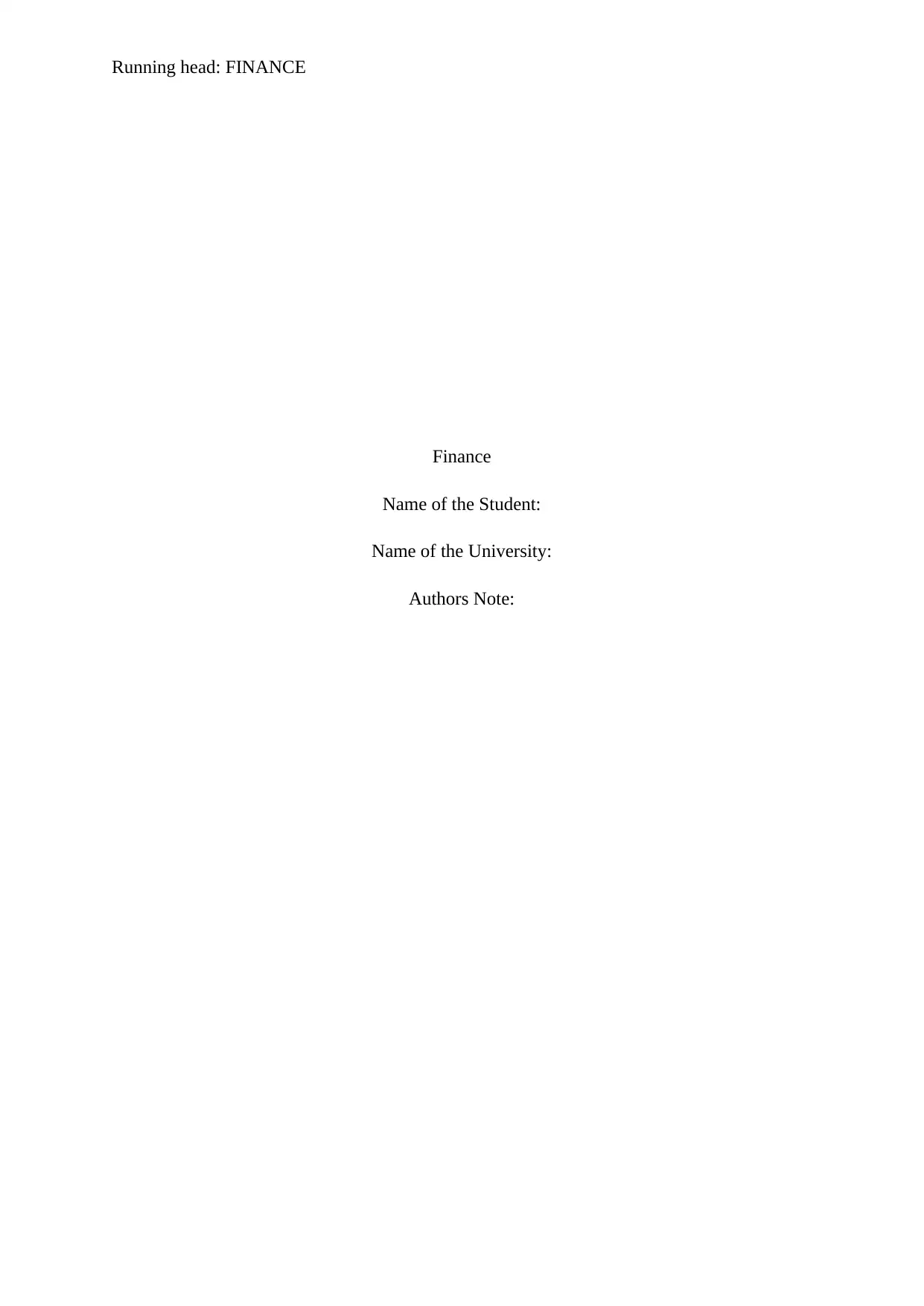
Running head: FINANCE
Finance
Name of the Student:
Name of the University:
Authors Note:
Finance
Name of the Student:
Name of the University:
Authors Note:
Secure Best Marks with AI Grader
Need help grading? Try our AI Grader for instant feedback on your assignments.
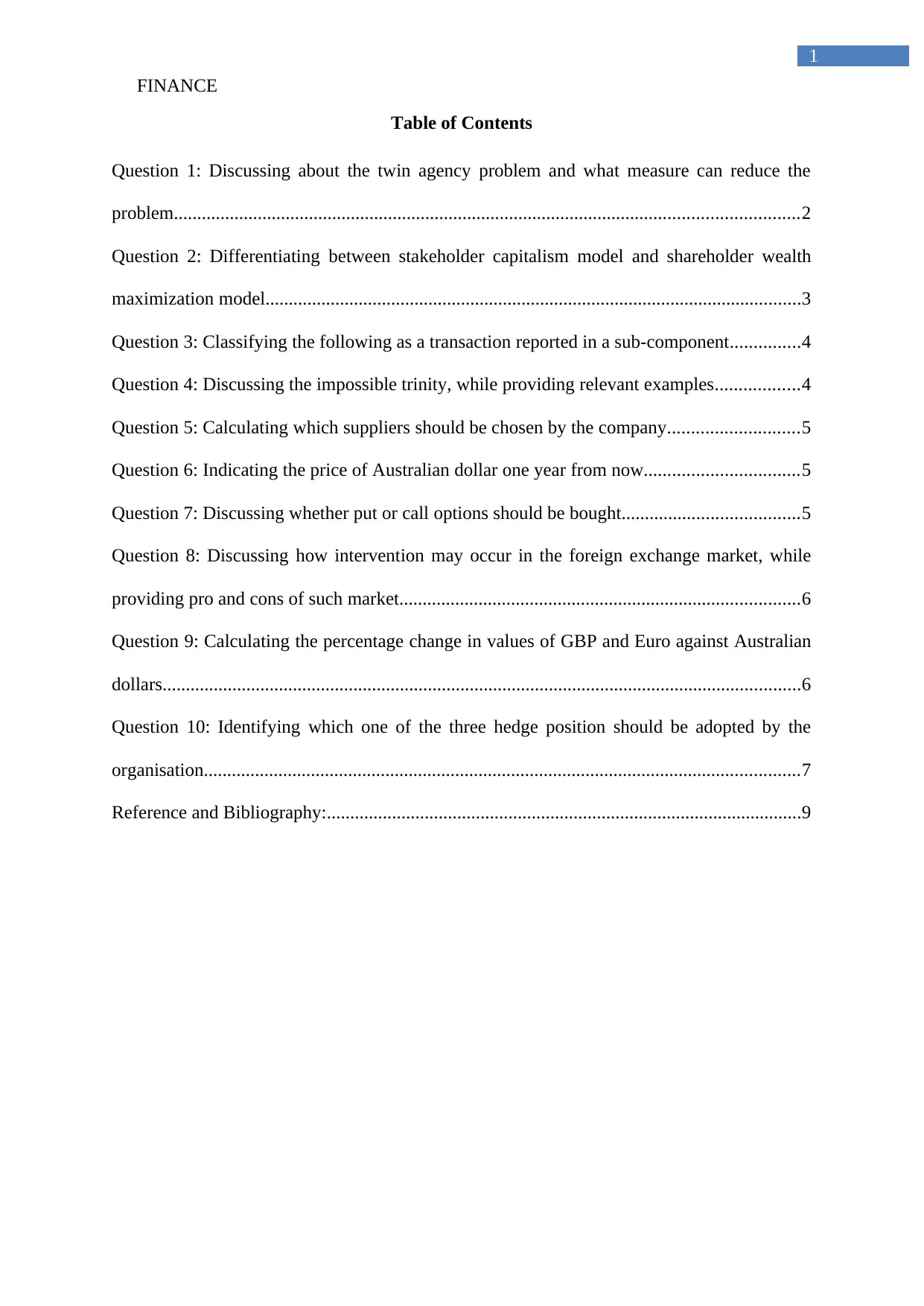
FINANCE
1
Table of Contents
Question 1: Discussing about the twin agency problem and what measure can reduce the
problem......................................................................................................................................2
Question 2: Differentiating between stakeholder capitalism model and shareholder wealth
maximization model...................................................................................................................3
Question 3: Classifying the following as a transaction reported in a sub-component...............4
Question 4: Discussing the impossible trinity, while providing relevant examples..................4
Question 5: Calculating which suppliers should be chosen by the company............................5
Question 6: Indicating the price of Australian dollar one year from now.................................5
Question 7: Discussing whether put or call options should be bought......................................5
Question 8: Discussing how intervention may occur in the foreign exchange market, while
providing pro and cons of such market......................................................................................6
Question 9: Calculating the percentage change in values of GBP and Euro against Australian
dollars.........................................................................................................................................6
Question 10: Identifying which one of the three hedge position should be adopted by the
organisation................................................................................................................................7
Reference and Bibliography:......................................................................................................9
1
Table of Contents
Question 1: Discussing about the twin agency problem and what measure can reduce the
problem......................................................................................................................................2
Question 2: Differentiating between stakeholder capitalism model and shareholder wealth
maximization model...................................................................................................................3
Question 3: Classifying the following as a transaction reported in a sub-component...............4
Question 4: Discussing the impossible trinity, while providing relevant examples..................4
Question 5: Calculating which suppliers should be chosen by the company............................5
Question 6: Indicating the price of Australian dollar one year from now.................................5
Question 7: Discussing whether put or call options should be bought......................................5
Question 8: Discussing how intervention may occur in the foreign exchange market, while
providing pro and cons of such market......................................................................................6
Question 9: Calculating the percentage change in values of GBP and Euro against Australian
dollars.........................................................................................................................................6
Question 10: Identifying which one of the three hedge position should be adopted by the
organisation................................................................................................................................7
Reference and Bibliography:......................................................................................................9
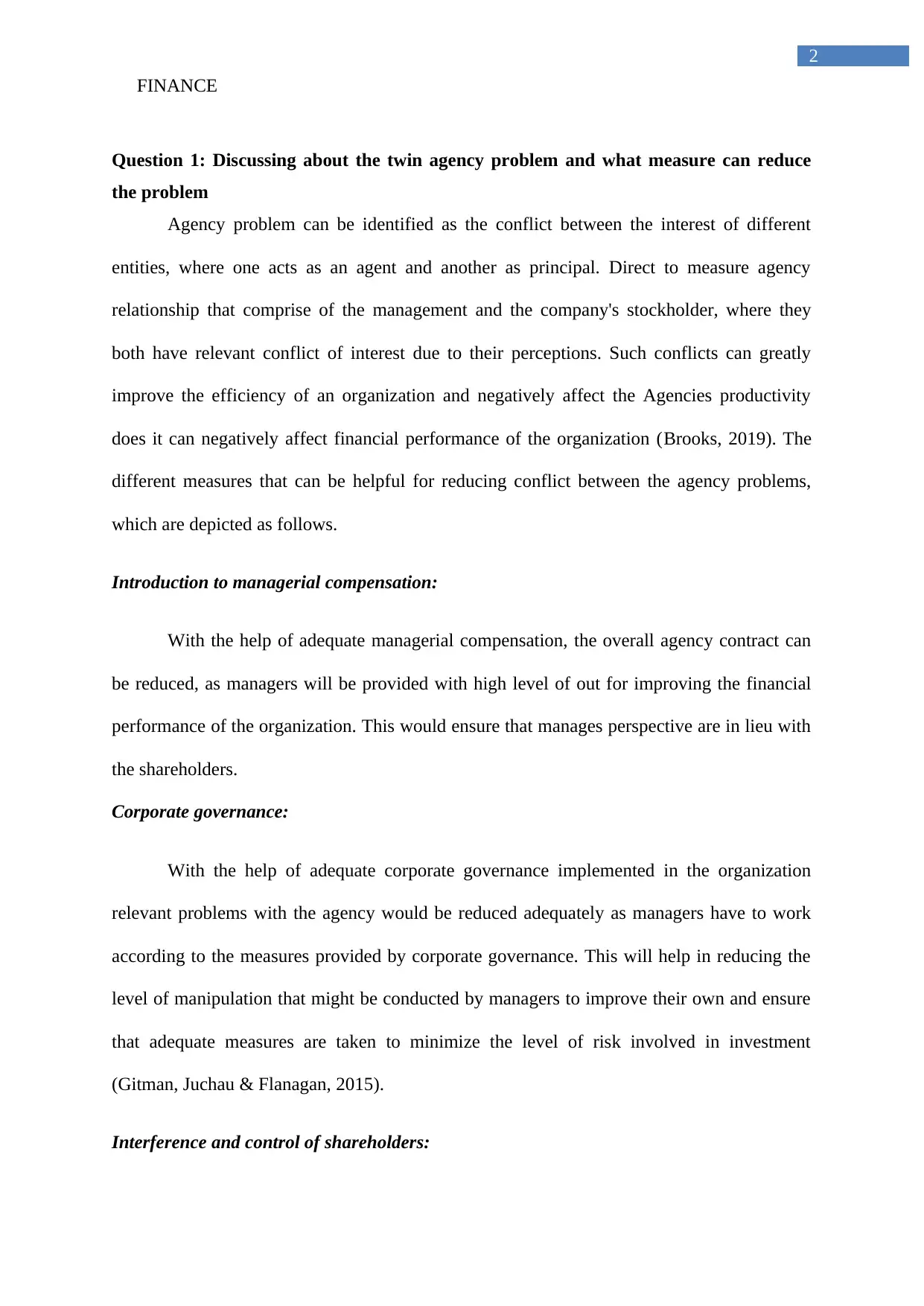
FINANCE
2
Question 1: Discussing about the twin agency problem and what measure can reduce
the problem
Agency problem can be identified as the conflict between the interest of different
entities, where one acts as an agent and another as principal. Direct to measure agency
relationship that comprise of the management and the company's stockholder, where they
both have relevant conflict of interest due to their perceptions. Such conflicts can greatly
improve the efficiency of an organization and negatively affect the Agencies productivity
does it can negatively affect financial performance of the organization (Brooks, 2019). The
different measures that can be helpful for reducing conflict between the agency problems,
which are depicted as follows.
Introduction to managerial compensation:
With the help of adequate managerial compensation, the overall agency contract can
be reduced, as managers will be provided with high level of out for improving the financial
performance of the organization. This would ensure that manages perspective are in lieu with
the shareholders.
Corporate governance:
With the help of adequate corporate governance implemented in the organization
relevant problems with the agency would be reduced adequately as managers have to work
according to the measures provided by corporate governance. This will help in reducing the
level of manipulation that might be conducted by managers to improve their own and ensure
that adequate measures are taken to minimize the level of risk involved in investment
(Gitman, Juchau & Flanagan, 2015).
Interference and control of shareholders:
2
Question 1: Discussing about the twin agency problem and what measure can reduce
the problem
Agency problem can be identified as the conflict between the interest of different
entities, where one acts as an agent and another as principal. Direct to measure agency
relationship that comprise of the management and the company's stockholder, where they
both have relevant conflict of interest due to their perceptions. Such conflicts can greatly
improve the efficiency of an organization and negatively affect the Agencies productivity
does it can negatively affect financial performance of the organization (Brooks, 2019). The
different measures that can be helpful for reducing conflict between the agency problems,
which are depicted as follows.
Introduction to managerial compensation:
With the help of adequate managerial compensation, the overall agency contract can
be reduced, as managers will be provided with high level of out for improving the financial
performance of the organization. This would ensure that manages perspective are in lieu with
the shareholders.
Corporate governance:
With the help of adequate corporate governance implemented in the organization
relevant problems with the agency would be reduced adequately as managers have to work
according to the measures provided by corporate governance. This will help in reducing the
level of manipulation that might be conducted by managers to improve their own and ensure
that adequate measures are taken to minimize the level of risk involved in investment
(Gitman, Juchau & Flanagan, 2015).
Interference and control of shareholders:
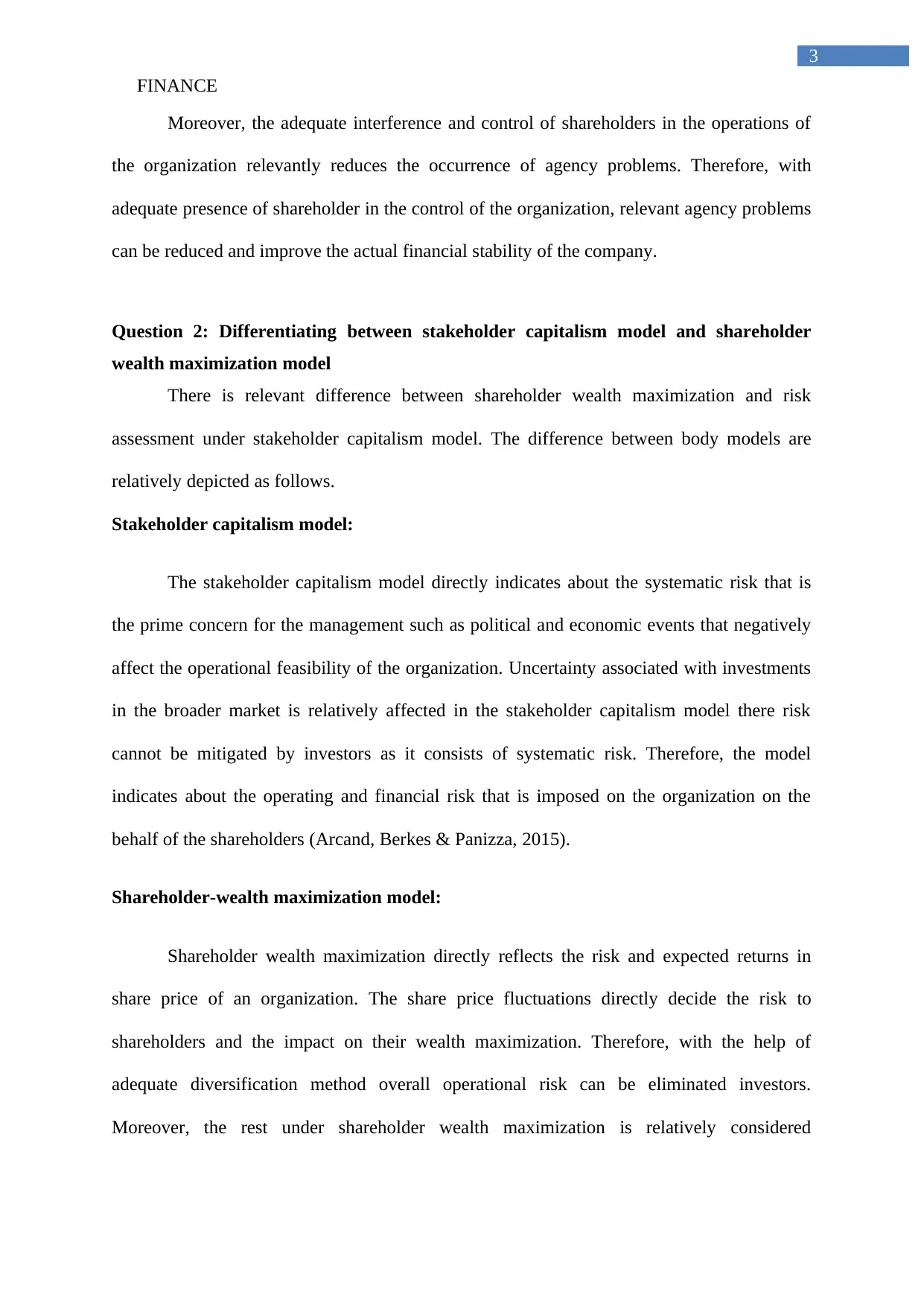
FINANCE
3
Moreover, the adequate interference and control of shareholders in the operations of
the organization relevantly reduces the occurrence of agency problems. Therefore, with
adequate presence of shareholder in the control of the organization, relevant agency problems
can be reduced and improve the actual financial stability of the company.
Question 2: Differentiating between stakeholder capitalism model and shareholder
wealth maximization model
There is relevant difference between shareholder wealth maximization and risk
assessment under stakeholder capitalism model. The difference between body models are
relatively depicted as follows.
Stakeholder capitalism model:
The stakeholder capitalism model directly indicates about the systematic risk that is
the prime concern for the management such as political and economic events that negatively
affect the operational feasibility of the organization. Uncertainty associated with investments
in the broader market is relatively affected in the stakeholder capitalism model there risk
cannot be mitigated by investors as it consists of systematic risk. Therefore, the model
indicates about the operating and financial risk that is imposed on the organization on the
behalf of the shareholders (Arcand, Berkes & Panizza, 2015).
Shareholder-wealth maximization model:
Shareholder wealth maximization directly reflects the risk and expected returns in
share price of an organization. The share price fluctuations directly decide the risk to
shareholders and the impact on their wealth maximization. Therefore, with the help of
adequate diversification method overall operational risk can be eliminated investors.
Moreover, the rest under shareholder wealth maximization is relatively considered
3
Moreover, the adequate interference and control of shareholders in the operations of
the organization relevantly reduces the occurrence of agency problems. Therefore, with
adequate presence of shareholder in the control of the organization, relevant agency problems
can be reduced and improve the actual financial stability of the company.
Question 2: Differentiating between stakeholder capitalism model and shareholder
wealth maximization model
There is relevant difference between shareholder wealth maximization and risk
assessment under stakeholder capitalism model. The difference between body models are
relatively depicted as follows.
Stakeholder capitalism model:
The stakeholder capitalism model directly indicates about the systematic risk that is
the prime concern for the management such as political and economic events that negatively
affect the operational feasibility of the organization. Uncertainty associated with investments
in the broader market is relatively affected in the stakeholder capitalism model there risk
cannot be mitigated by investors as it consists of systematic risk. Therefore, the model
indicates about the operating and financial risk that is imposed on the organization on the
behalf of the shareholders (Arcand, Berkes & Panizza, 2015).
Shareholder-wealth maximization model:
Shareholder wealth maximization directly reflects the risk and expected returns in
share price of an organization. The share price fluctuations directly decide the risk to
shareholders and the impact on their wealth maximization. Therefore, with the help of
adequate diversification method overall operational risk can be eliminated investors.
Moreover, the rest under shareholder wealth maximization is relatively considered
Secure Best Marks with AI Grader
Need help grading? Try our AI Grader for instant feedback on your assignments.
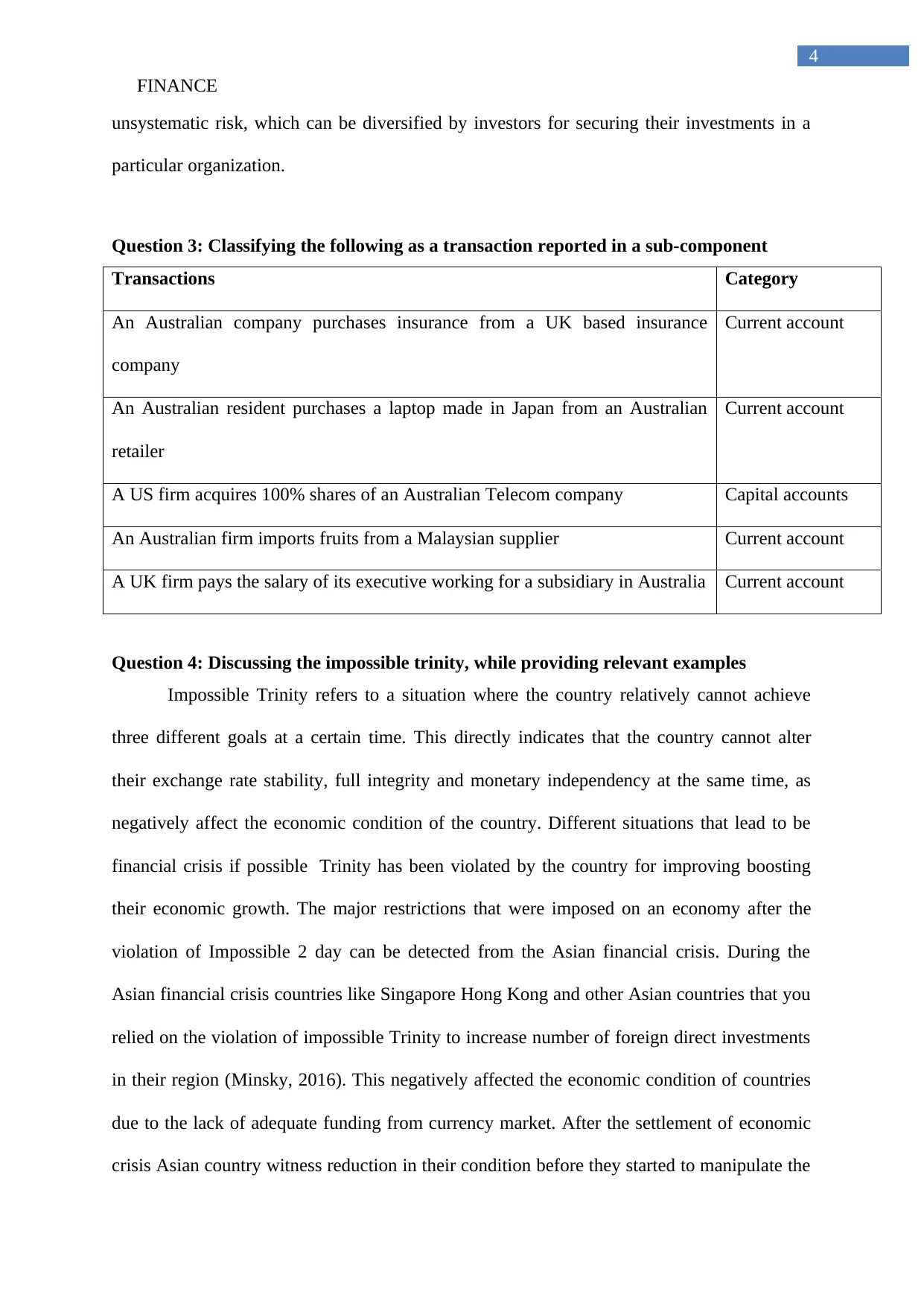
FINANCE
4
unsystematic risk, which can be diversified by investors for securing their investments in a
particular organization.
Question 3: Classifying the following as a transaction reported in a sub-component
Transactions Category
An Australian company purchases insurance from a UK based insurance
company
Current account
An Australian resident purchases a laptop made in Japan from an Australian
retailer
Current account
A US firm acquires 100% shares of an Australian Telecom company Capital accounts
An Australian firm imports fruits from a Malaysian supplier Current account
A UK firm pays the salary of its executive working for a subsidiary in Australia Current account
Question 4: Discussing the impossible trinity, while providing relevant examples
Impossible Trinity refers to a situation where the country relatively cannot achieve
three different goals at a certain time. This directly indicates that the country cannot alter
their exchange rate stability, full integrity and monetary independency at the same time, as
negatively affect the economic condition of the country. Different situations that lead to be
financial crisis if possible Trinity has been violated by the country for improving boosting
their economic growth. The major restrictions that were imposed on an economy after the
violation of Impossible 2 day can be detected from the Asian financial crisis. During the
Asian financial crisis countries like Singapore Hong Kong and other Asian countries that you
relied on the violation of impossible Trinity to increase number of foreign direct investments
in their region (Minsky, 2016). This negatively affected the economic condition of countries
due to the lack of adequate funding from currency market. After the settlement of economic
crisis Asian country witness reduction in their condition before they started to manipulate the
4
unsystematic risk, which can be diversified by investors for securing their investments in a
particular organization.
Question 3: Classifying the following as a transaction reported in a sub-component
Transactions Category
An Australian company purchases insurance from a UK based insurance
company
Current account
An Australian resident purchases a laptop made in Japan from an Australian
retailer
Current account
A US firm acquires 100% shares of an Australian Telecom company Capital accounts
An Australian firm imports fruits from a Malaysian supplier Current account
A UK firm pays the salary of its executive working for a subsidiary in Australia Current account
Question 4: Discussing the impossible trinity, while providing relevant examples
Impossible Trinity refers to a situation where the country relatively cannot achieve
three different goals at a certain time. This directly indicates that the country cannot alter
their exchange rate stability, full integrity and monetary independency at the same time, as
negatively affect the economic condition of the country. Different situations that lead to be
financial crisis if possible Trinity has been violated by the country for improving boosting
their economic growth. The major restrictions that were imposed on an economy after the
violation of Impossible 2 day can be detected from the Asian financial crisis. During the
Asian financial crisis countries like Singapore Hong Kong and other Asian countries that you
relied on the violation of impossible Trinity to increase number of foreign direct investments
in their region (Minsky, 2016). This negatively affected the economic condition of countries
due to the lack of adequate funding from currency market. After the settlement of economic
crisis Asian country witness reduction in their condition before they started to manipulate the
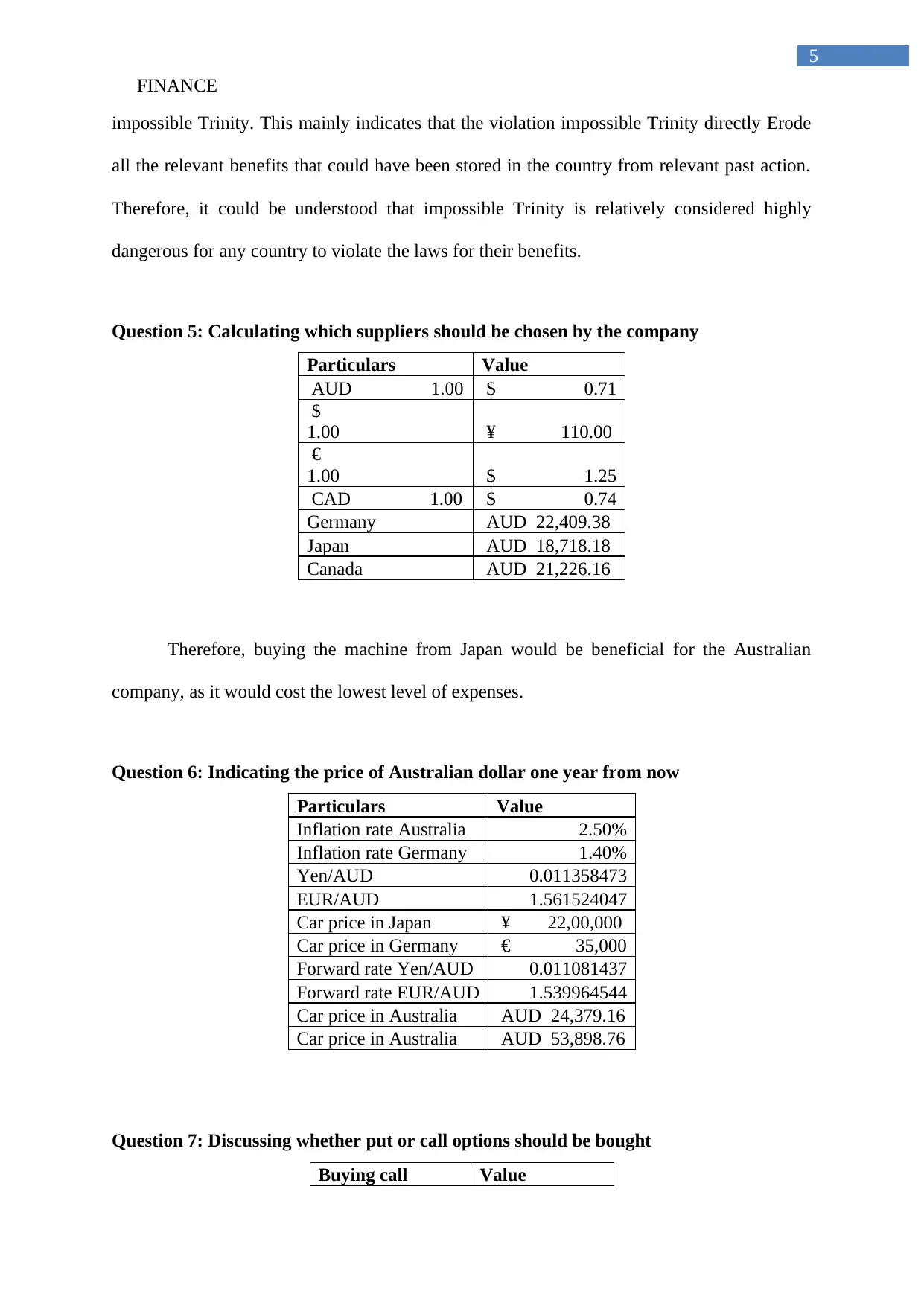
FINANCE
5
impossible Trinity. This mainly indicates that the violation impossible Trinity directly Erode
all the relevant benefits that could have been stored in the country from relevant past action.
Therefore, it could be understood that impossible Trinity is relatively considered highly
dangerous for any country to violate the laws for their benefits.
Question 5: Calculating which suppliers should be chosen by the company
Particulars Value
AUD 1.00 $ 0.71
$
1.00 ¥ 110.00
€
1.00 $ 1.25
CAD 1.00 $ 0.74
Germany AUD 22,409.38
Japan AUD 18,718.18
Canada AUD 21,226.16
Therefore, buying the machine from Japan would be beneficial for the Australian
company, as it would cost the lowest level of expenses.
Question 6: Indicating the price of Australian dollar one year from now
Particulars Value
Inflation rate Australia 2.50%
Inflation rate Germany 1.40%
Yen/AUD 0.011358473
EUR/AUD 1.561524047
Car price in Japan ¥ 22,00,000
Car price in Germany € 35,000
Forward rate Yen/AUD 0.011081437
Forward rate EUR/AUD 1.539964544
Car price in Australia AUD 24,379.16
Car price in Australia AUD 53,898.76
Question 7: Discussing whether put or call options should be bought
Buying call Value
5
impossible Trinity. This mainly indicates that the violation impossible Trinity directly Erode
all the relevant benefits that could have been stored in the country from relevant past action.
Therefore, it could be understood that impossible Trinity is relatively considered highly
dangerous for any country to violate the laws for their benefits.
Question 5: Calculating which suppliers should be chosen by the company
Particulars Value
AUD 1.00 $ 0.71
$
1.00 ¥ 110.00
€
1.00 $ 1.25
CAD 1.00 $ 0.74
Germany AUD 22,409.38
Japan AUD 18,718.18
Canada AUD 21,226.16
Therefore, buying the machine from Japan would be beneficial for the Australian
company, as it would cost the lowest level of expenses.
Question 6: Indicating the price of Australian dollar one year from now
Particulars Value
Inflation rate Australia 2.50%
Inflation rate Germany 1.40%
Yen/AUD 0.011358473
EUR/AUD 1.561524047
Car price in Japan ¥ 22,00,000
Car price in Germany € 35,000
Forward rate Yen/AUD 0.011081437
Forward rate EUR/AUD 1.539964544
Car price in Australia AUD 24,379.16
Car price in Australia AUD 53,898.76
Question 7: Discussing whether put or call options should be bought
Buying call Value
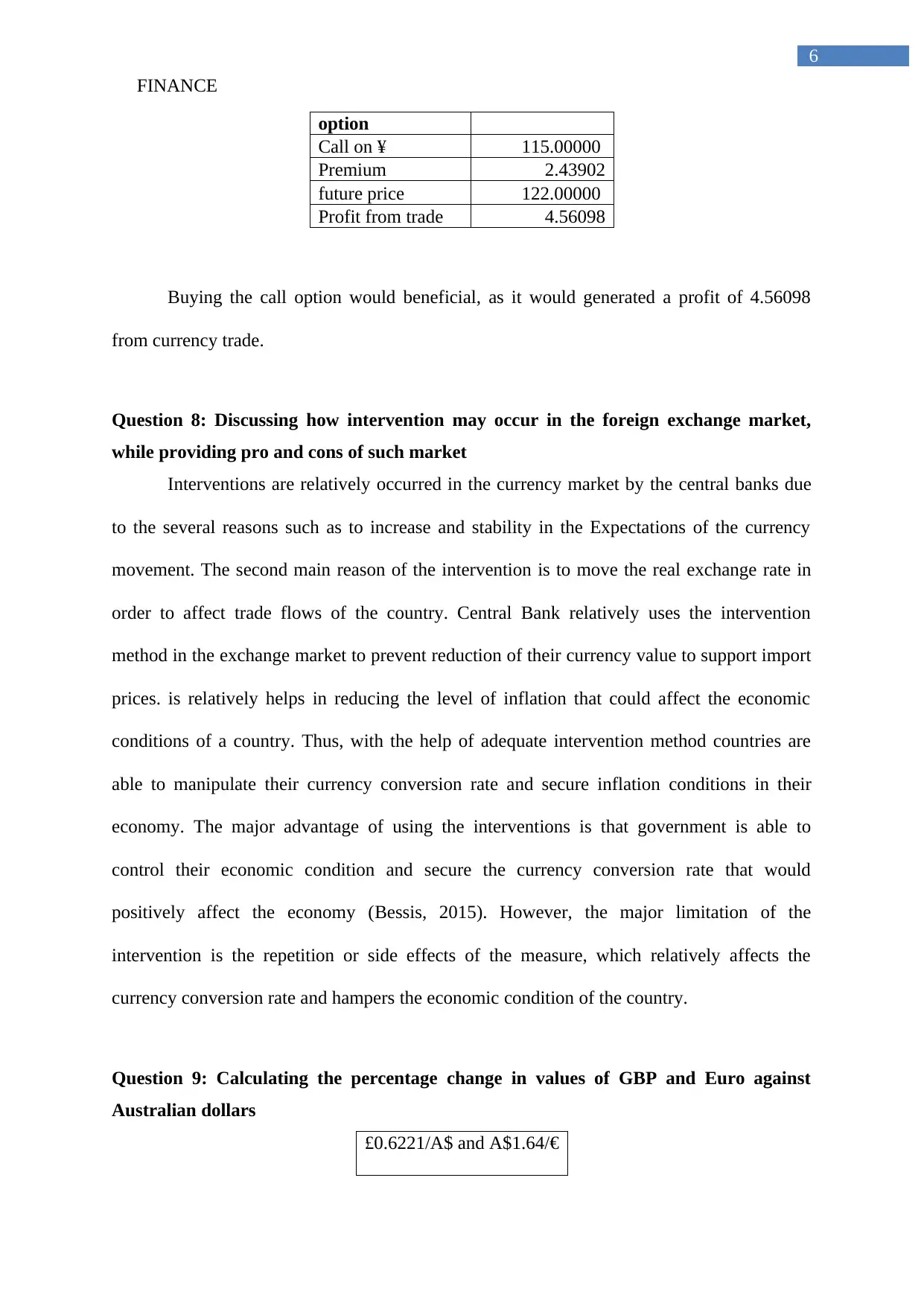
FINANCE
6
option
Call on ¥ 115.00000
Premium 2.43902
future price 122.00000
Profit from trade 4.56098
Buying the call option would beneficial, as it would generated a profit of 4.56098
from currency trade.
Question 8: Discussing how intervention may occur in the foreign exchange market,
while providing pro and cons of such market
Interventions are relatively occurred in the currency market by the central banks due
to the several reasons such as to increase and stability in the Expectations of the currency
movement. The second main reason of the intervention is to move the real exchange rate in
order to affect trade flows of the country. Central Bank relatively uses the intervention
method in the exchange market to prevent reduction of their currency value to support import
prices. is relatively helps in reducing the level of inflation that could affect the economic
conditions of a country. Thus, with the help of adequate intervention method countries are
able to manipulate their currency conversion rate and secure inflation conditions in their
economy. The major advantage of using the interventions is that government is able to
control their economic condition and secure the currency conversion rate that would
positively affect the economy (Bessis, 2015). However, the major limitation of the
intervention is the repetition or side effects of the measure, which relatively affects the
currency conversion rate and hampers the economic condition of the country.
Question 9: Calculating the percentage change in values of GBP and Euro against
Australian dollars
£0.6221/A$ and A$1.64/€
6
option
Call on ¥ 115.00000
Premium 2.43902
future price 122.00000
Profit from trade 4.56098
Buying the call option would beneficial, as it would generated a profit of 4.56098
from currency trade.
Question 8: Discussing how intervention may occur in the foreign exchange market,
while providing pro and cons of such market
Interventions are relatively occurred in the currency market by the central banks due
to the several reasons such as to increase and stability in the Expectations of the currency
movement. The second main reason of the intervention is to move the real exchange rate in
order to affect trade flows of the country. Central Bank relatively uses the intervention
method in the exchange market to prevent reduction of their currency value to support import
prices. is relatively helps in reducing the level of inflation that could affect the economic
conditions of a country. Thus, with the help of adequate intervention method countries are
able to manipulate their currency conversion rate and secure inflation conditions in their
economy. The major advantage of using the interventions is that government is able to
control their economic condition and secure the currency conversion rate that would
positively affect the economy (Bessis, 2015). However, the major limitation of the
intervention is the repetition or side effects of the measure, which relatively affects the
currency conversion rate and hampers the economic condition of the country.
Question 9: Calculating the percentage change in values of GBP and Euro against
Australian dollars
£0.6221/A$ and A$1.64/€
Paraphrase This Document
Need a fresh take? Get an instant paraphrase of this document with our AI Paraphraser
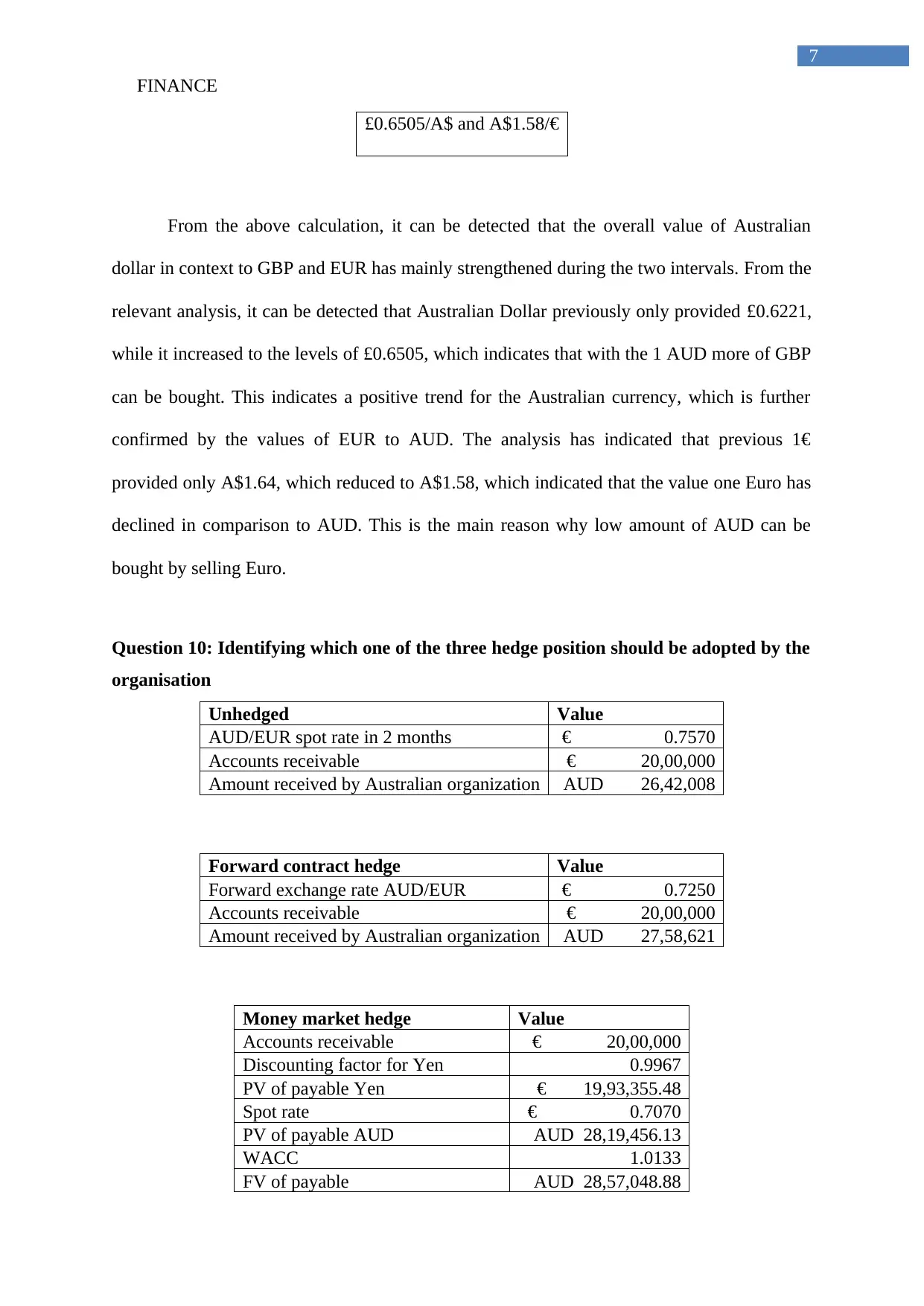
FINANCE
7
£0.6505/A$ and A$1.58/€
From the above calculation, it can be detected that the overall value of Australian
dollar in context to GBP and EUR has mainly strengthened during the two intervals. From the
relevant analysis, it can be detected that Australian Dollar previously only provided £0.6221,
while it increased to the levels of £0.6505, which indicates that with the 1 AUD more of GBP
can be bought. This indicates a positive trend for the Australian currency, which is further
confirmed by the values of EUR to AUD. The analysis has indicated that previous 1€
provided only A$1.64, which reduced to A$1.58, which indicated that the value one Euro has
declined in comparison to AUD. This is the main reason why low amount of AUD can be
bought by selling Euro.
Question 10: Identifying which one of the three hedge position should be adopted by the
organisation
Unhedged Value
AUD/EUR spot rate in 2 months € 0.7570
Accounts receivable € 20,00,000
Amount received by Australian organization AUD 26,42,008
Forward contract hedge Value
Forward exchange rate AUD/EUR € 0.7250
Accounts receivable € 20,00,000
Amount received by Australian organization AUD 27,58,621
Money market hedge Value
Accounts receivable € 20,00,000
Discounting factor for Yen 0.9967
PV of payable Yen € 19,93,355.48
Spot rate € 0.7070
PV of payable AUD AUD 28,19,456.13
WACC 1.0133
FV of payable AUD 28,57,048.88
7
£0.6505/A$ and A$1.58/€
From the above calculation, it can be detected that the overall value of Australian
dollar in context to GBP and EUR has mainly strengthened during the two intervals. From the
relevant analysis, it can be detected that Australian Dollar previously only provided £0.6221,
while it increased to the levels of £0.6505, which indicates that with the 1 AUD more of GBP
can be bought. This indicates a positive trend for the Australian currency, which is further
confirmed by the values of EUR to AUD. The analysis has indicated that previous 1€
provided only A$1.64, which reduced to A$1.58, which indicated that the value one Euro has
declined in comparison to AUD. This is the main reason why low amount of AUD can be
bought by selling Euro.
Question 10: Identifying which one of the three hedge position should be adopted by the
organisation
Unhedged Value
AUD/EUR spot rate in 2 months € 0.7570
Accounts receivable € 20,00,000
Amount received by Australian organization AUD 26,42,008
Forward contract hedge Value
Forward exchange rate AUD/EUR € 0.7250
Accounts receivable € 20,00,000
Amount received by Australian organization AUD 27,58,621
Money market hedge Value
Accounts receivable € 20,00,000
Discounting factor for Yen 0.9967
PV of payable Yen € 19,93,355.48
Spot rate € 0.7070
PV of payable AUD AUD 28,19,456.13
WACC 1.0133
FV of payable AUD 28,57,048.88
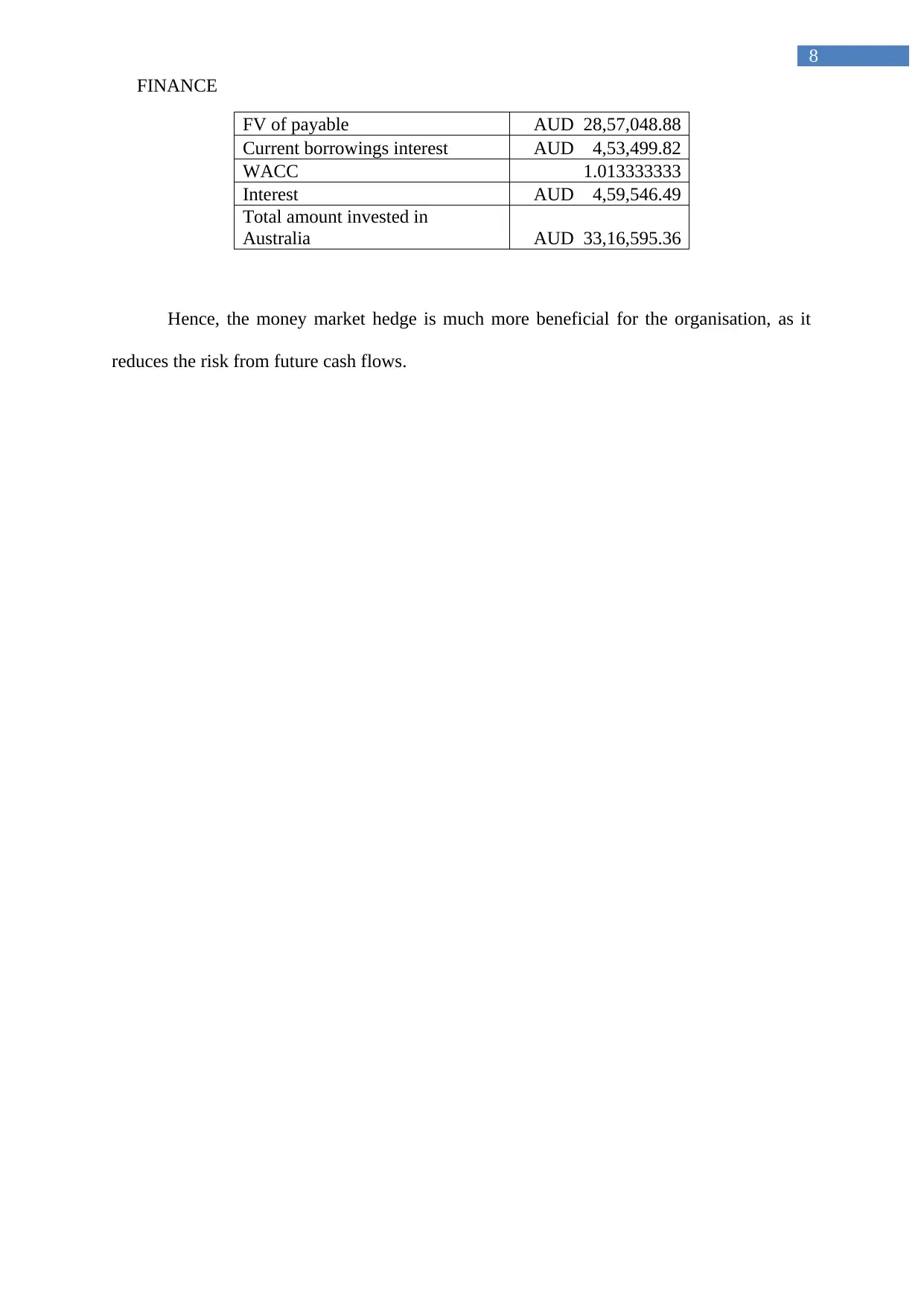
FINANCE
8
FV of payable AUD 28,57,048.88
Current borrowings interest AUD 4,53,499.82
WACC 1.013333333
Interest AUD 4,59,546.49
Total amount invested in
Australia AUD 33,16,595.36
Hence, the money market hedge is much more beneficial for the organisation, as it
reduces the risk from future cash flows.
8
FV of payable AUD 28,57,048.88
Current borrowings interest AUD 4,53,499.82
WACC 1.013333333
Interest AUD 4,59,546.49
Total amount invested in
Australia AUD 33,16,595.36
Hence, the money market hedge is much more beneficial for the organisation, as it
reduces the risk from future cash flows.
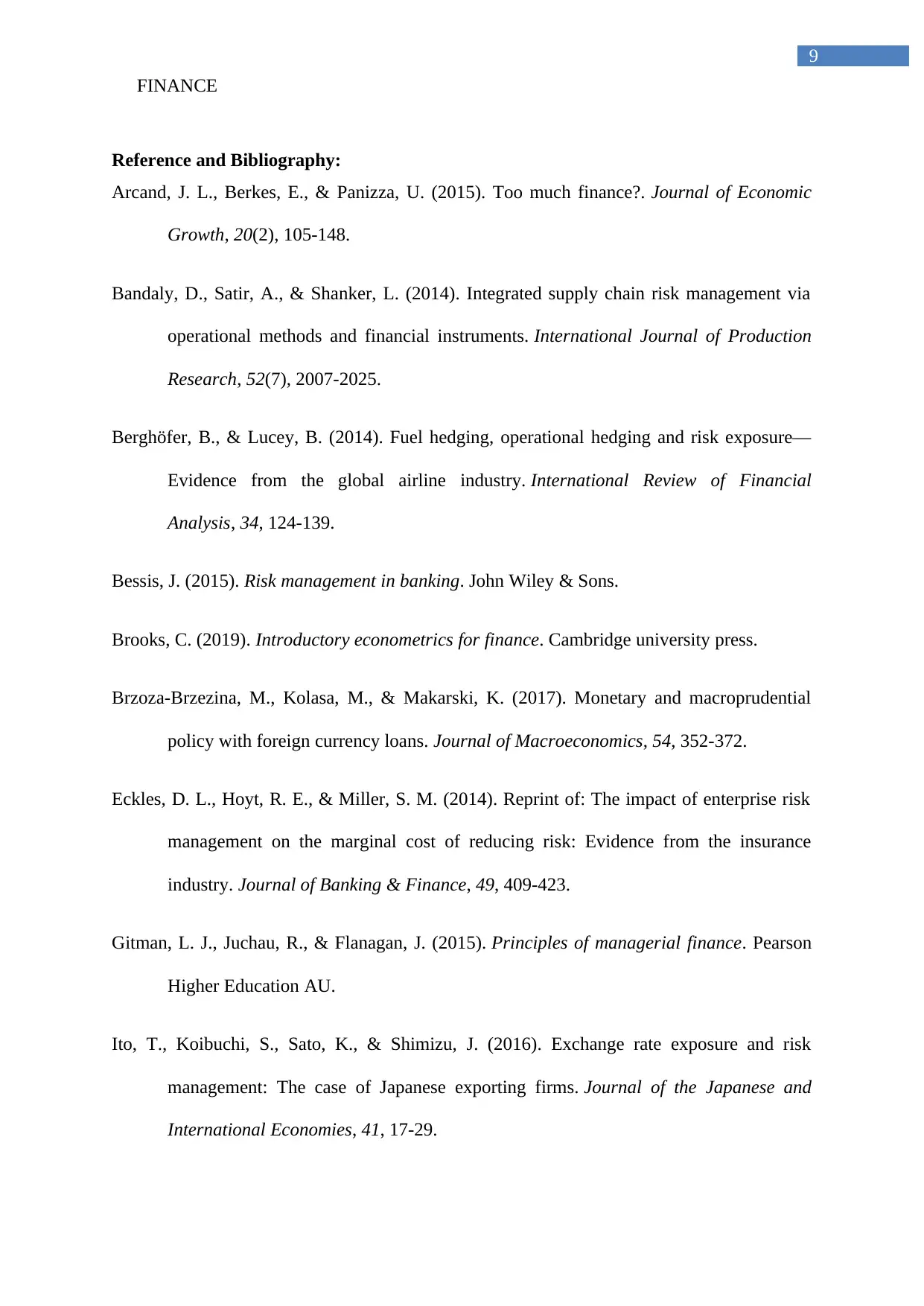
FINANCE
9
Reference and Bibliography:
Arcand, J. L., Berkes, E., & Panizza, U. (2015). Too much finance?. Journal of Economic
Growth, 20(2), 105-148.
Bandaly, D., Satir, A., & Shanker, L. (2014). Integrated supply chain risk management via
operational methods and financial instruments. International Journal of Production
Research, 52(7), 2007-2025.
Berghöfer, B., & Lucey, B. (2014). Fuel hedging, operational hedging and risk exposure—
Evidence from the global airline industry. International Review of Financial
Analysis, 34, 124-139.
Bessis, J. (2015). Risk management in banking. John Wiley & Sons.
Brooks, C. (2019). Introductory econometrics for finance. Cambridge university press.
Brzoza-Brzezina, M., Kolasa, M., & Makarski, K. (2017). Monetary and macroprudential
policy with foreign currency loans. Journal of Macroeconomics, 54, 352-372.
Eckles, D. L., Hoyt, R. E., & Miller, S. M. (2014). Reprint of: The impact of enterprise risk
management on the marginal cost of reducing risk: Evidence from the insurance
industry. Journal of Banking & Finance, 49, 409-423.
Gitman, L. J., Juchau, R., & Flanagan, J. (2015). Principles of managerial finance. Pearson
Higher Education AU.
Ito, T., Koibuchi, S., Sato, K., & Shimizu, J. (2016). Exchange rate exposure and risk
management: The case of Japanese exporting firms. Journal of the Japanese and
International Economies, 41, 17-29.
9
Reference and Bibliography:
Arcand, J. L., Berkes, E., & Panizza, U. (2015). Too much finance?. Journal of Economic
Growth, 20(2), 105-148.
Bandaly, D., Satir, A., & Shanker, L. (2014). Integrated supply chain risk management via
operational methods and financial instruments. International Journal of Production
Research, 52(7), 2007-2025.
Berghöfer, B., & Lucey, B. (2014). Fuel hedging, operational hedging and risk exposure—
Evidence from the global airline industry. International Review of Financial
Analysis, 34, 124-139.
Bessis, J. (2015). Risk management in banking. John Wiley & Sons.
Brooks, C. (2019). Introductory econometrics for finance. Cambridge university press.
Brzoza-Brzezina, M., Kolasa, M., & Makarski, K. (2017). Monetary and macroprudential
policy with foreign currency loans. Journal of Macroeconomics, 54, 352-372.
Eckles, D. L., Hoyt, R. E., & Miller, S. M. (2014). Reprint of: The impact of enterprise risk
management on the marginal cost of reducing risk: Evidence from the insurance
industry. Journal of Banking & Finance, 49, 409-423.
Gitman, L. J., Juchau, R., & Flanagan, J. (2015). Principles of managerial finance. Pearson
Higher Education AU.
Ito, T., Koibuchi, S., Sato, K., & Shimizu, J. (2016). Exchange rate exposure and risk
management: The case of Japanese exporting firms. Journal of the Japanese and
International Economies, 41, 17-29.
Secure Best Marks with AI Grader
Need help grading? Try our AI Grader for instant feedback on your assignments.
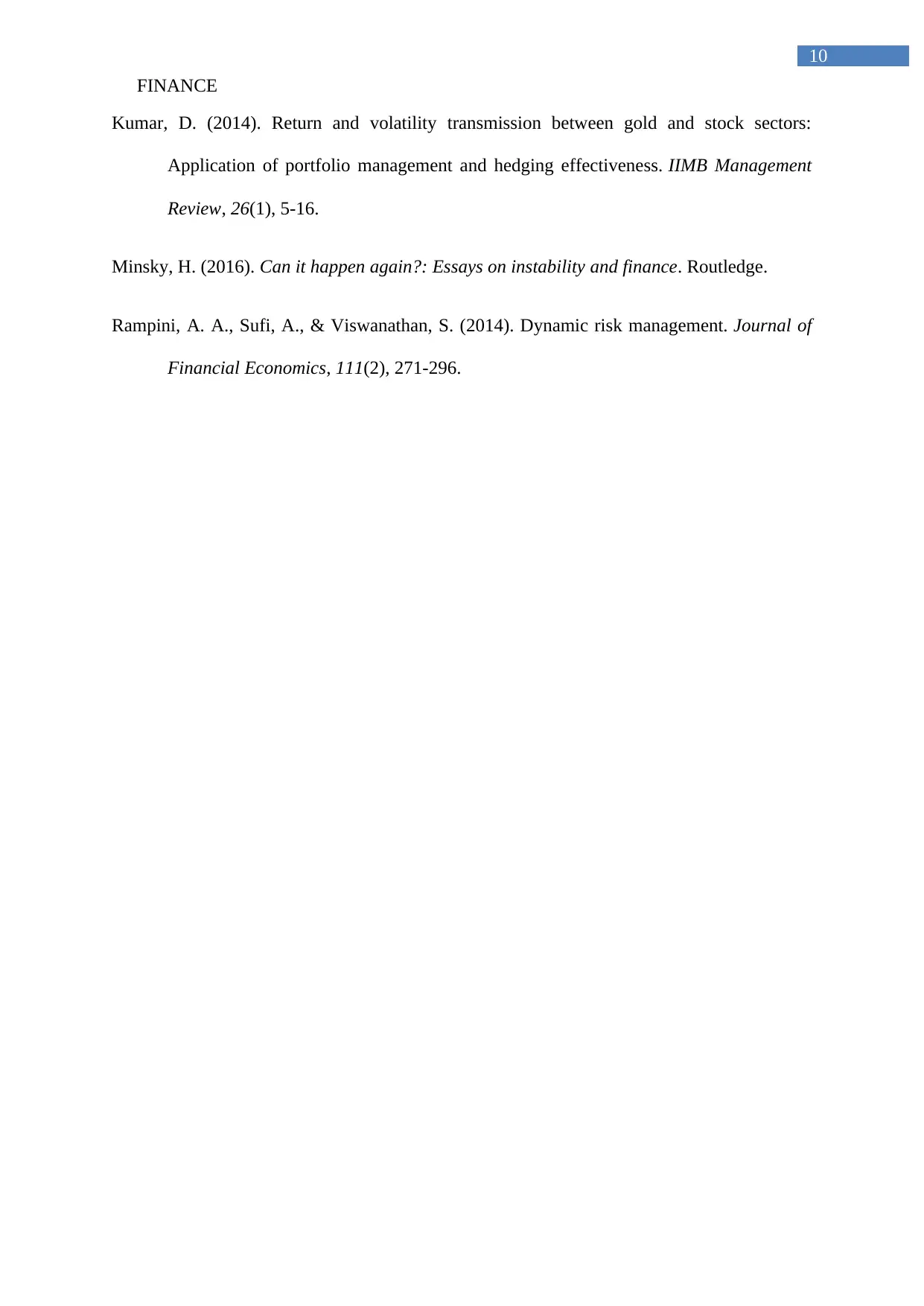
FINANCE
10
Kumar, D. (2014). Return and volatility transmission between gold and stock sectors:
Application of portfolio management and hedging effectiveness. IIMB Management
Review, 26(1), 5-16.
Minsky, H. (2016). Can it happen again?: Essays on instability and finance. Routledge.
Rampini, A. A., Sufi, A., & Viswanathan, S. (2014). Dynamic risk management. Journal of
Financial Economics, 111(2), 271-296.
10
Kumar, D. (2014). Return and volatility transmission between gold and stock sectors:
Application of portfolio management and hedging effectiveness. IIMB Management
Review, 26(1), 5-16.
Minsky, H. (2016). Can it happen again?: Essays on instability and finance. Routledge.
Rampini, A. A., Sufi, A., & Viswanathan, S. (2014). Dynamic risk management. Journal of
Financial Economics, 111(2), 271-296.
1 out of 11
Related Documents
Your All-in-One AI-Powered Toolkit for Academic Success.
+13062052269
info@desklib.com
Available 24*7 on WhatsApp / Email
![[object Object]](/_next/static/media/star-bottom.7253800d.svg)
Unlock your academic potential
© 2024 | Zucol Services PVT LTD | All rights reserved.





